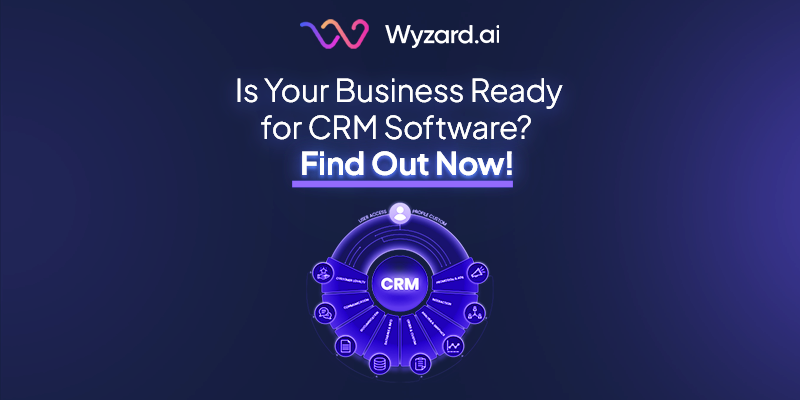Hi, I am Wyzard, your visionary guide in a world where the buying experience is transforming. The way we ...
Everything You Need to Know About SaaS Spend Management in 2024
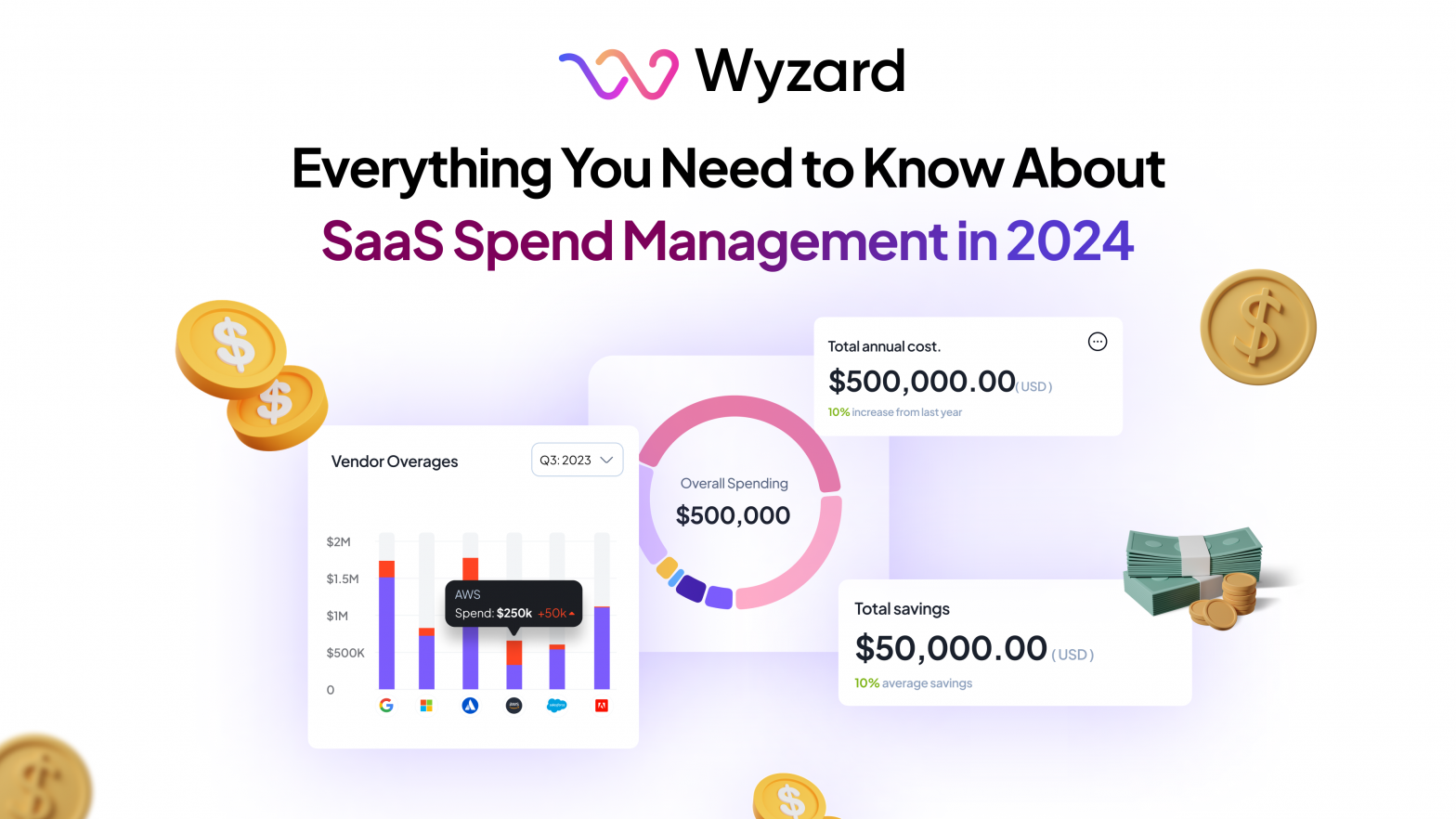

Subscribe Now
SaaS, or software as most people call it, has become an integral part of modern business operations. With the flexibility and scalability they offer, it’s no wonder that organizations of all sizes are looking for more and more SaaS solutions.
However, as the number of SaaS applications within an organization grows, so does the cost and complexity of managing them. Unmanaged SaaS spend comes with significant challenges, such as compliance issues, security vulnerabilities, and overspending on redundant or underutilized applications.
This is where SaaS spend management comes in. It allows you to take control of your SaaS ecosystem, ensuring that every dollar spent on software delivers tangible value.
In this guide, we’ll look into the significance of SaaS spend management for businesses and how a robust SaaS spend management tool can help you with cost optimization.
Let’s dive right in!
What is SaaS Spend Management?
In simple terms, SaaS spend management is all about keeping a close watch on the money you’re forking out for those nifty cloud-based software solutions.
Let’s say you’ve got a truckload of SaaS apps in your business, each with its own pricing plan, renewal dates, and usage metrics. Without a proper system in place, it’s easy to lose track of who’s using what and whether you’re getting your money’s worth. And this system is what we call SaaS spend management.
It’s a strategic approach that helps you monitor, analyze, and optimize your SaaS investments from start to finish. Think of it as a financial fitness routine for your business’s software budget.
The best part? With SaaS spend management, you’re not just saving money; you’re also ensuring that your organization stays compliant, secure, and aligned with its overall goals. It’s a win-win situation, really.
Why is effective SaaS spend management required?
Look at the number of SaaS applications you use. As you grow, know that the number of software applications will only increase. Without an effective SaaS spend management strategy, you’ll almost certainly end up paying for all kinds of software and features you don’t even need.
Here’s what SaaS spend management can assist you with:
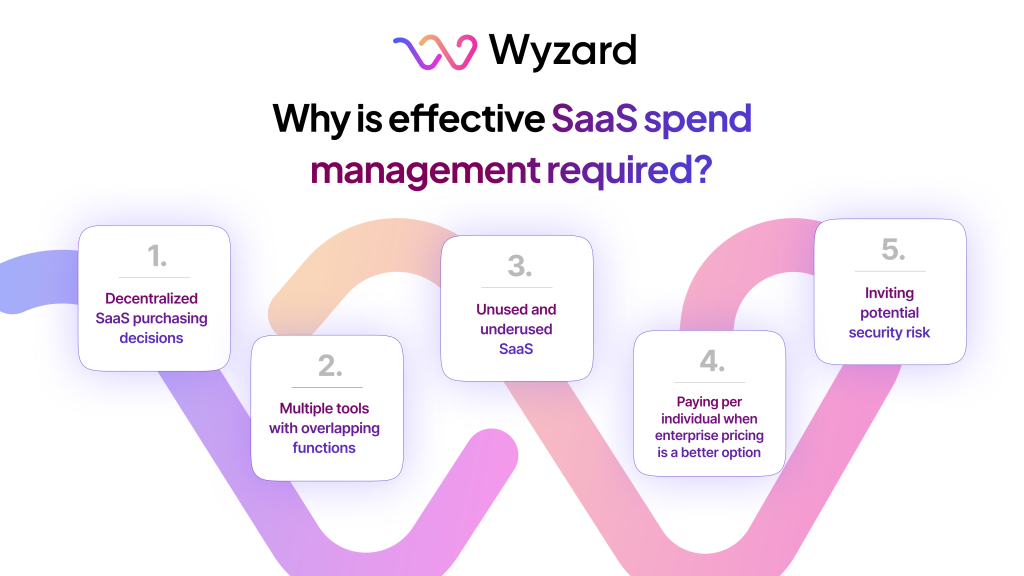
1. Decentralized SaaS purchasing decisions
Let’s say you’re a part of a larger organization, where each department makes their own decisions (separately) to acquire SaaS applications. Without a centralized strategy, it’s like having multiple captains on a ship all wanting to steer in different directions—chaos is guaranteed and you’ll miss opportunities for synergy.
This decentralized approach often leads to “shadow IT,” where employees acquire SaaS applications without the knowledge or approval of the IT department. Only the people involved know about the software, but the company pays. While this might seem harmless at first, it can quickly spiral into a mess of security risks and budget overruns.
Did you know that 8 out of 10 employees admitted to using SaaS apps at work without IT approval?
An effective SaaS spend management solution sends out proactive alerts whenever an unsanctioned application is detected. This early warning system allows you to nip shadow IT in the bud, ensuring that your organization remains in control of its software spend.
2. Multiple tools with overlapping functions
Without a centralized SaaS strategy, your teams may acquire tools that essentially serve the same purpose, leading to unnecessary costs and redundancies.
It’s like having multiple streaming subscriptions for the same shows – sure, they all get the job done, but wouldn’t it be more efficient (and cost-effective) to consolidate your subscriptions?
This happens because your team has no clarity on if the company already has an alternative solution that solves the same problem.
That’s where SaaS spend management comes into play. It helps you identify these overlapping tools, allowing you to streamline your software ecosystem and cut down on duplicate costs.
3. Unused and underused SaaS
Paying for a gym membership you never use—we’ve all been there. The same principle applies to software subscriptions. Organizations often pay for SaaS subscriptions that are underutilized or completely unused.
Effective SaaS spend management requires regularly reviewing the active user count for each tool. If a tool isn’t being used as expected, organizations can consider reducing the number of licenses or engaging users more effectively to maximize the investment.
SaaS spend management platforms like Wyzard provide granular insights into software usage patterns. You can assess how frequently software from each vendor is used, review category-wise software utilization metrics, and even explore usage patterns across different teams. When you have this information, you can make informed decisions about optimizing your SaaS spend, ensuring that every dollar counts.
4. Paying per individual when enterprise pricing is a better option
In some cases, organizations may be paying for individual licenses when an enterprise pricing plan would be more cost-effective.
SaaS spend management helps you identify instances where enterprise pricing could be a more economical option, allowing you to leverage your organization’s size and negotiate better deals with vendors.
5. Inviting potential security risk
There’s often little to no procedure in place for offboarding employees from all the SaaS apps they previously had access to. This results in you paying unnecessary costs and inviting potential security risks.
Moreover, SaaS spend management is not only about saving money on software; it’s also about eliminating the cost of data breaches. Did you know that 20% of companies have experienced data breaches from ex-employees? If you don’t know who used which app, you’ll never be able to guess that they were supposed to be offboarded. And by the time you know whose license it was behind the data breach, it’ll be too late.
Effective SaaS spend management ensures that you have a clear understanding of who has access to which applications, allowing you to revoke licenses promptly when an employee leaves the organization. This simple step can save you significant costs and protect your organization’s valuable data.
Why can’t you say no to SaaS spend management?
Here are some of the many benefits you get when you have a dedicated software spend management process in place:
1. Optimize SaaS cost
Every dollar counts, and organizations can’t afford to let their SaaS expenses spiral out of control. SaaS spend management allows you to take a proactive approach to addressing unused, underused, and redundant applications.
This proactive approach allows you to free up resources for new licenses and software training. By optimizing your SaaS portfolio, you can ensure that you’re getting the most bang for your buck without sacrificing the tools and capabilities your teams need to thrive.
2. Better SaaS utilization
SaaS spend optimization isn’t just about cost-cutting; it’s also about maximizing the value you derive from your software investments.
An optimized SaaS portfolio leads to more efficient software utilization, with each team making the most of every app at their disposal.
By eliminating redundancies and consolidating overlapping tools, you can streamline your processes and boost productivity. This ensures that your teams have access to the right tools for the job.
3. Reduce security vulnerabilities
Irrespective of the size of your organization, cybersecurity has to be a top priority. The visibility that comes with centralized SaaS spend management can help reduce your risk of cyberattacks targeting cloud-based applications.
By keeping a close eye on who has access to which SaaS tools, you can promptly revoke licenses for former employees, mitigating the risk of data breaches and unauthorized access.
Additionally, a streamlined SaaS portfolio makes it easier to stay on top of security updates and patches, ensuring that your organization remains vigilant against evolving cyber threats.
4. Better budgeting and forecasting
Effective SaaS spend management also enables better budgeting and forecasting for future costs. With a dedicated SaaS spend management process in place, you gain valuable insights into your organization’s software usage patterns, historical spending data, and projected growth.
This information allows you to create accurate budgets that account for your evolving software needs, ensuring that you allocate resources effectively and avoid unexpected expenses.
Predictive analytics and forecasting capabilities can help you anticipate future software requirements. And hence, negotiate better deals with vendors.
Ultimately, better budgeting and forecasting allow you to align your SaaS spending with your organization’s long-term goals.
5. Streamline renewals and contract negotiations
Keeping track of renewal dates, negotiating favorable contract terms, and ensuring compliance—these tasks can take a lifetime if you’re managing multiple SaaS subscriptions.
However, when you have a robust SaaS spend management process in place, coupled with a dedicated platform like Wyzard, these tasks become much more manageable.
SaaS spend management platforms can streamline renewals by providing timely notifications and assisting with contract negotiations.
By consolidating your SaaS portfolio and leveraging your organization’s buying power, you can secure better deals and favorable terms from vendors, further optimizing your SaaS spend.
5 best practices for effective SaaS spend management
When you look at it from a distance—you think it’s pretty easy to manage your SaaS spends because all you have to do is figure out who’s using what and make some cuts.
But as you come closer, you’ll realize that given the number of employees, the number of SaaS applications, and the features all of these software offer—all you’ll be doing is scraping the tip of the iceberg.
And even if you do manage to make some cuts, your spend management will always be reactive, i.e., optimization after paying more. However, to maximize your software savings, your SaaS spend management process needs to be predictive and proactive.
You must follow a process, and here are some best practices to get you started with SaaS spend management:
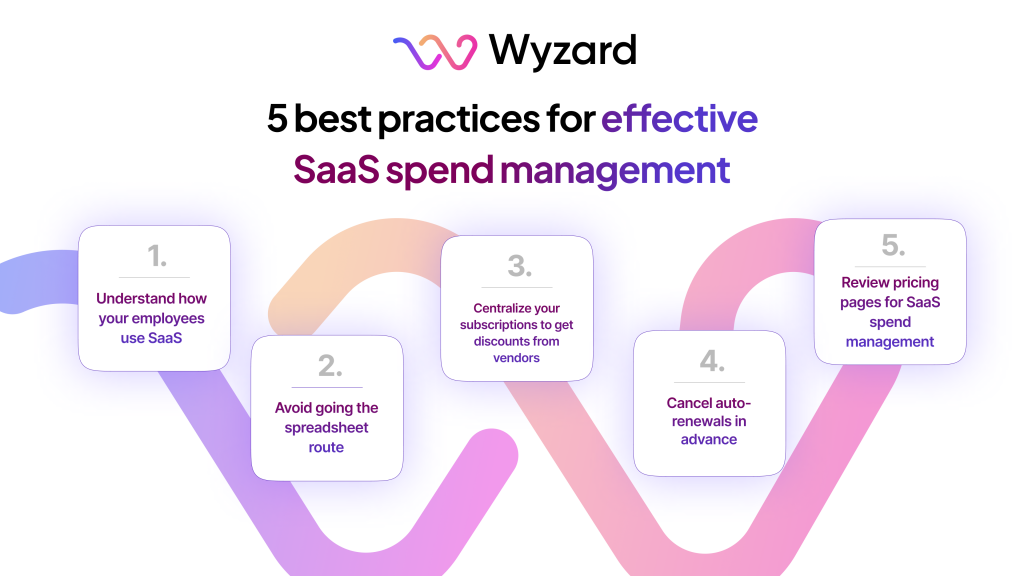
1. Understand how your employees use SaaS
To effectively manage your SaaS spend, you need to have a deep understanding of how your employees use different software tools.
This includes identifying which features they use, which ones they don’t need, whether there are alternative tools with a more targeted feature set, and if different departments are using separate apps for the same tasks.
However, remember that gathering this information manually can be time-consuming and labor-intensive, especially in larger organizations.
2. Avoid going the spreadsheet route
For small teams with a handful of software, managing subscriptions and expenses through a spreadsheet might still be a viable option.
But, as your organization grows and the number of apps and employees increases, this approach quickly becomes unsustainable.
Spreadsheets are prone to errors, lack automation, and can become unwieldy, making it difficult to maintain an accurate and up-to-date overview of your SaaS portfolio.
3. Centralize your subscriptions to get discounts from vendors
Different departments might be paying for the same software separately, losing out on the opportunity to use your organization’s buying power and get bulk discounts from vendors.
Centralizing your subscriptions not only helps you negotiate better deals but also streamlines your SaaS portfolio, reducing redundancies and overlapping tools.
While this is an essential practice, manually tracking and consolidating subscriptions across various departments is still a challenge.
4. Cancel auto-renewals in advance
Sometimes, you may want to switch to a different software solution, but by the time you notice, your current subscription has already been auto-renewed.
Cancellations of the auto-renewed software often increase costs, as most SaaS subscriptions are non-refundable.
Additionally, missing renewal dates can prevent you from having sufficient time to negotiate or optimize your current contracts, risking business continuity for critical software.
AI-powered SaaS spend management tools like Wyzard can organize the renewal dates of your SaaS portfolio from your contracts and provide advanced reminders about upcoming renewals, giving you ample time to decide whether to renew, switch, or renegotiate your subscription.
5. Review pricing pages for SaaS spend management
For those willing to manually manage their SaaS spend, reviewing pricing pages is a way to find the best price and determine if you’re eligible for a better plan.
However, doing this for every SaaS tool your organization uses can be exhausting and time-consuming.
SaaS spend management tools can streamline this process, providing a centralized platform to review and optimize your software subscriptions, saving you time and effort.
How SaaS spend management tools can help you optimize cost?
The best practices we’ve mentioned above are really helpful. However, implementing them to manage your organization’s SaaS spend manually is a task that requires extensive research, time, and effort.
Furthermore, this process is prone to errors, making it challenging to optimize your software investments effectively.
SaaS spend management tools offer a more efficient and accurate approach, providing valuable insights and streamlining processes to help you optimize costs.
With Wyzard, you can take control of your SaaS portfolio and make data-driven decisions to optimize your software spend.
Here’s how SaaS spend management tools can help you:
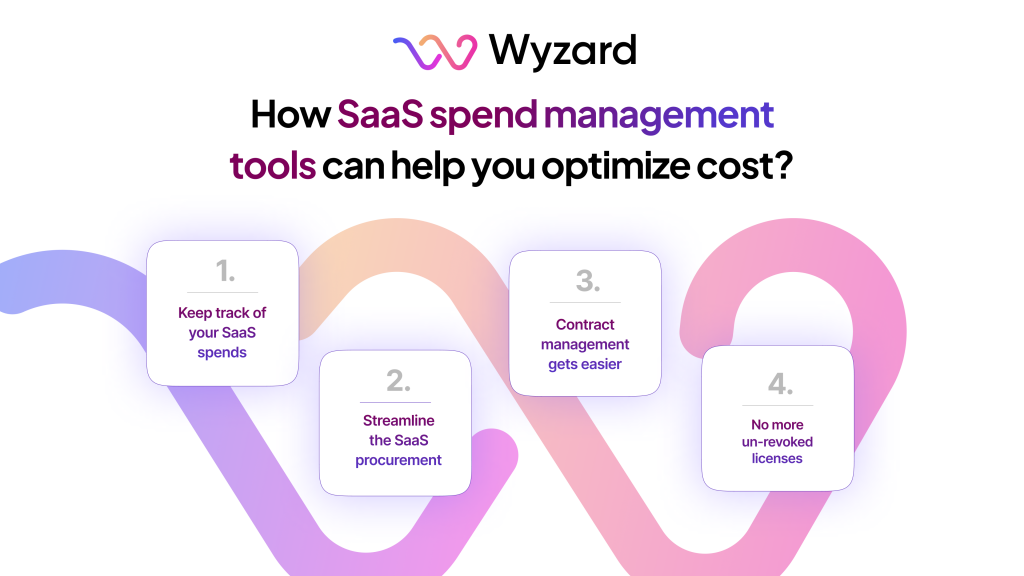
1. Keep track of your SaaS spends
AI-powered insights from Wyzard reveal actionable strategies to optimize your costs. The platform detects underutilized licenses, hidden apps, and duplicate applications, enabling you to eliminate these sources of expense wastage and prevent unnecessary spending.
2. Streamline the SaaS procurement
Wyzard helps you secure the best pricing for your current and new software by providing a centralized platform for managing your spend analytics, budgeting, and forecasting. You can conduct detailed research on vendors, compare prices, and read reviews. Once you have all the required information, Wyzard can help you secure the best deal.
3. Contract management gets easier
With Wyzard, you can centralize your SaaS contracts and vendors for easy management, giving you a bird’s eye view of your entire SaaS stack. This approach simplifies renewals, pricing negotiations, and benchmarking, ensuring that you’re always getting the best value for your software investments.
4. No more un-revoked licenses
SaaS spend management platforms like Wyzard can easily identify every SaaS application an employee uses. When an employee leaves the company, you can promptly revoke their licenses, preventing unnecessary costs and potential security risks associated with unauthorized access.
By using SaaS spend management tools, you can identify areas for cost optimization and make data-driven decisions to reduce costs without compromising on the tools and capabilities your teams need to thrive.
Moreover, these platforms offer automation and scalability, ensuring that your SaaS spend management processes remain efficient and effective as your organization grows and evolves.
Manage your SaaS spend with Wyzard
Let’s be real, managing your SaaS spend can quickly become a headache if you’re trying to do it all manually. Sure, you could spend countless hours poring over spreadsheets, digging through pricing pages, and tracking down those elusive renewal dates—but who has time for that?
That’s where a SaaS spend management platform like Wyzard comes into play. It’s like having a virtual assistant dedicated to keeping your software investments in check. No more guesswork, no more missed opportunities, and no more wasted dollars.
With Wyzard, you’ll gain a crystal-clear understanding of which applications are being used, who’s using them, and how they’re impacting your team’s productivity.
But don’t just take our word for it. Book a free demo today!
Other blogs
The latest industry news, interviews, technologies, and resources.
March 17, 2025
How LLM-Based AI Agents are Simplifying the Software Buying Process for Businesses
Let’s talk about something that’s becoming a game-changer in our daily lives: AI agents. Think of them as your ...

March 11, 2025
Is Your Business Ready for CRM Software? Find Out Now!
Running a small business can feel like juggling a million things at once. You are busy with customers, ensuring ...

Subscribe
Today!
Error: Contact form not found.
Subscribe to learn about new product features, the latest in technology, solutions, and updates.
 Meet Us at
Meet Us at 


